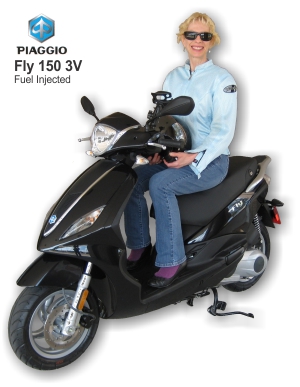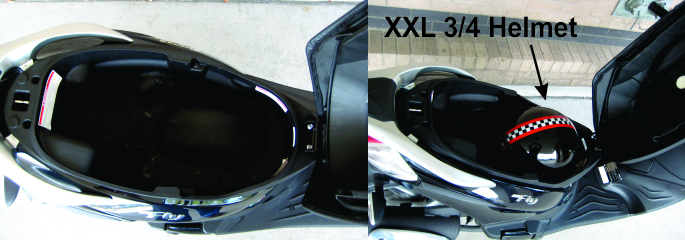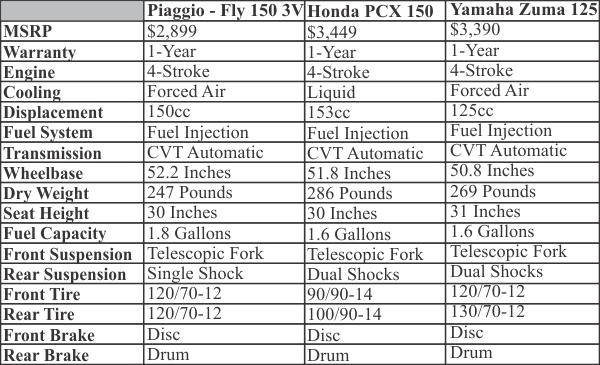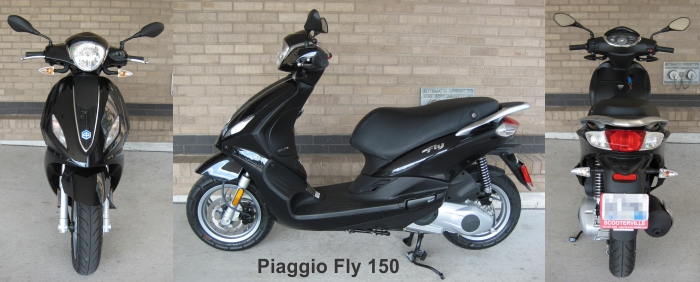August, 2013
Man, time just flies by. It’s been way too long since a new review has been posted here. Today we’re taking a look at the new Piaggio Fly 150 with a three-valve fuel injected powerplant. Why is it so tough to review a scooter these days? Aside from building the scooter, Piaggio had nothing to do with this review. Like Honda, Yamaha, Suzuki and BMW, Piaggio has made it clear to me that they DON’T put “review” scooters in the hands of people who run websites like JustGottaScoot.com. We are not considered a “legitimate” media source because we don’t accept advertising. That’s right, we won’t take their advertising money, so we get no scooters to review. It’s ONLY through the largess of dealers like Bob at Scooterville that we have any chance to put some miles on Piaggion/Vespa scooters.
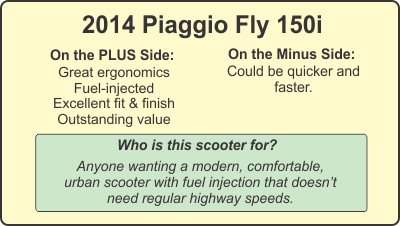
This review began with going through the pre-delivery process on the Fly 150. Aside from some whining (which is different from sniveling) about the use of TORX fasteners as opposed to good old Philips screws, everything went fine. The battery is located inside the glove box and installing it requires the removal of the horn cast, but the location frees up storage space under the seat so I’m OK with the modicum of extra work. Evidence of the new (to me) Piaggio attention to detail was obvious during the pre-delivery procedure.
Speedometer Reading/Speed/Fuel Economy
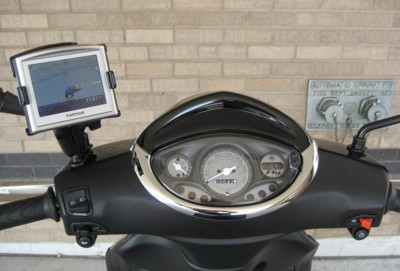
The speedometer is biased toward kilometers with miles displayed in smaller numbers on the inner part of the display. The odometer displayed kilometers. Like most scooters we review, the Piaggio Fly 150 reads optimistically. The speedometer indicates 10% faster than actual speed. An indicated 30 MPH is actually 27 MPH and an indicated 50 MPH is actually 45 MPH. The odometer was very close to spot on. My 18.5 kilometer trip to the office (GPS verified) indicated 18.5 on the odometer. Piaggio claims the Fly 150 has a top speed of 61 MPH and gets 104 MPG. The fastest GPS speed I saw was 58 MPH and that was with a bit of a tailwind. I managed 86 MPG during the review which I consider to be very good. This was a brand new scooter that was NOT yet broken in. I expect that both top speed and fuel economy would improve after engine break-in. With some more miles (sorry, I meant kilometers) on the Fly 150 AND a rider who DOESN’T weigh 220 pounds, I would expect 61 to be easily obtainable. As to the 104 MPG……. I don’t see that being realistic.
Features
The Piaggio Fly 150 is powered by a 150cc air-cooled and fuel-injected, single over-head cam three-valve single cylinder engine, it gets power 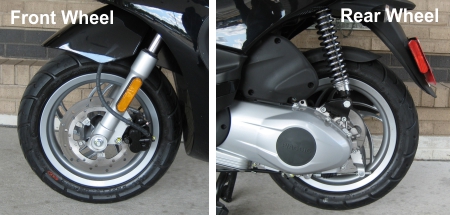
Moving down we find a glove box that would be good for, well, gloves. Small ones at that, I don’t think I could cram my huge winter riding gloves in there. Half the glove box is given up to the battery, but I’m fine with that. Just below the glove box is the fuel filler. It’s locked by key and is in a location that made it a touch tricky to fill the scooter. This “low” fuel tank is a sure sign of fuel injection. Carbureted scooters rely on gravity (and vacuum) to feed fuel and, as such, have tanks higher up. Easier to fill, but worse for weight distribution. I will gladly exercise caution in filling my scooter to gain the myriad advantages of fuel injection.
Underseat storage is very good on the Fly 150. It was no trouble at all to fit my melon-head XXL three-quarter helmet under the seat with room to spare. Hey, look, there’s no battery or fuel filler to steal storage space from me under there! 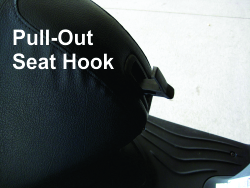
Lighting is very good which was really thrown in my face after a ride on an older small displacement motorcycle. Dim headlights, weak brake lights and barely visible turn signals aren’t all that noticeable to the rider UNLESS one hops off an old motorcycle or scooter and on to a newer one. Wow. The road in front of me was suddenly clearly visible. I parked side-by-side and looked at the brake lights and turn signals – what a difference good lighting makes. The turn signals on the Piaggio Fly 150 even look good and fit well with the overall design of the scooter. Another clear indicator of good design and execution are the rear-view mirrors. They are VERY well shaped, both to look good on the scooter and to provide an exceptionally good view of what’s going on behind one. The angle at which they are set is even wide enough for the full-figured among us to clearly see more than one’s own shoulders.
Passenger accommodations are nice with a large seat and flip out foot pegs so the person on back isn’t required to take up the cowboy stance required of passengers on so many other scooters. The features of the Piaggio Fly 150 add up to a well designed and well made scooter with high quality components. I really didn’t find anything to complain about so far as the features of the Fly are concerned.
Riding Impressions
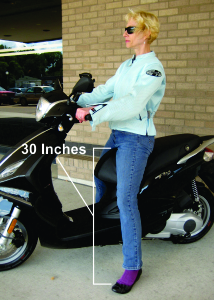
Sitting on the Fly 150 with the engine running and getting ready to take off I was struck by just how nice the ergonomics of this scooter are. The stock seat is roomy and very comfortable. The reach to the controls was just right. Leg room and foot room are amble. The seat height of 30 inches makes the Fly 150 more approachable for new riders than other, “taller” models. Entering traffic I noticed how smooth the acceleration was. Nothing to write home about off the line, a Genuine Buddy would rocket ahead of a Fly, but more than adequate. Power delivery is smooth and even throughout the speed range with no dead spots. Of course it goes without saying that I wanted more acceleration AND more top end, but I could say that about nearly every scooter I’ve ever ridden. The Fly 150 will easily keep up with traffic and gives enough ooomph up to about 50 MPH. Getting the rest of speed capability out of the Fly took a bit.
Handling is very good thanks to a firm suspension and steering geometry perfectly suited to the size of the scooter and its twelve inch tires. Some other riders I have spoken with found the suspension a touch harsh, but I like a firm ride. The Fly 150 takes a line quickly and holds it well, something a softly suspended scooter won’t do. The ground clearance runs out long before the handling capabilities of scooter reach their limit. The center stand hits first (and often) during spirited riding. Braking is more than adequate. Yes, one can wish for disc rear brake that the Europeans get on THEIR fly, but I found the disc/drum combination to be strong and easy to modulate with no apparent fade in normal riding. The strong brakes and good suspension contribute to drama-free sudden changes in direction and speed when the idiot in the VW in front of you is too busy texting to actually drive.
The Fly 150 was a great deal of fun to ride and did everything I asked of it. My daily ride includes about 25 – 30 miles of streets and parkways with posted speeds up to 45MPH. On the rare occasions that traffic isn’t completely bogged down, I have several routes to and from work that involves twisties and speeds of about 50 MPH (I was just keeping up with traffic officer). As long as you don’t try and make a highway cruiser out of it, the Fly 150 would be a wonderful daily rider.
Fit & Finish
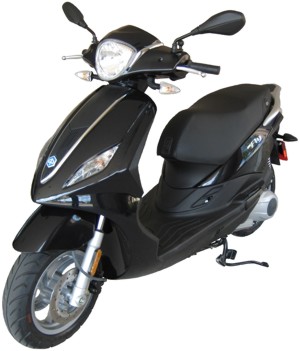
Piaggio Fly 150 vs. The Competition
I’ve selected the Honda PCX 150 and Yamaha Zuma 125 as comparisons for the Piaggio Fly 150. I’ve reviewed the Zuma, and I’ve ridden a couple of PCX scooters, though I haven’t done a formal review. In my opinion, the Piaggio Fly 150 is a better scooter than the Zuma in every category. The Honda PCX is both quicker and faster than the Fly 150, though I don’t find it to be nearly as comfortable and I think the Fly is better looking. So far as bang-for-the-buck goes, the Fly 150 is the clear winner. As this is the first year in the US market for this version of the Fly 150, I’m going to hold off adding it to my “what scooter should I buy” list. If Piaggio can hold the line on quality, pricing, and continue to demonstrate good support, I’ll certainly be adding the Fly 150 to my list.
Conclusions
After reviewing the Piaggio BV350, I was looking forward to the Fly 150. It appears that Piaggio is bringing us new products that are not only on par with Honda, Yamaha and other top tier companies, but doing it at a price point that represents an outstanding value. I know that a lot of you are tired of me sounding like a broken record when it comes to a recommendation for a city scooter. It seems I spout “Buy a Buddy” over and over again. OK, here’s something else for you to consider, especially if you’re looking for a scooter a bit physically bigger than a Buddy.
Again, a big THANK YOU to Bob at Scooterville in Minneapolis for providing the scooter used in this review.
David Harrington

